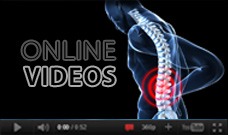Adolescent Idiopathic Scoliosis
Adolescent idiopathic scoliosis (AIS) is undoubtedly an excessive curvature of the back on the left or right. Scoliosis distorts the spine and its look from the front, posterior, and lateral aspect. The image below depicts posterior view of scoliosis.
AIS observed in 1% to 3% children aged between 10 to 16 years.1 It may start at the age of puberty as well as during growth spurt. Idiopathic means explanation for scoliosis has not been identified. Studies have shown that a few adolescents have an innate predisposition for AIS. 2 There is a female predisposition for the development of AIS. Being a progressive disorder, the excessive curvature of the spine may deteriorate further, if not managed appropriately.
How to understand?
Occasionally you don't. At times adolescent idiopathic scoliosis is identified by teachers at school, uncovered after a routine bodily evaluation; else you might observe some few bodily deformities in your child’s physical appearance.
The common signs and symptoms of adolescent idiopathic scoliosis include difference in the length of both the lower limbs, abnormal gait, difference in the levels of both the shoulders, prominence of the rib or shoulder blade when the patient leans forward, prominent curvature of the spine, tilting of the hip, lack of uniformity in hemlines and trouser lengths, improper fitting of clothes, and backache.
AIS and deformity
Being a progressive disorder, adolescent idiopathic scoliosis can result in considerable deformity if not treated appropriately. The spinal deformity can lead to psychological distress your child due to a feeling of inferiority. The physical consequences are serious as well.
Adolescent idiopathic scoliosis can cause rotation of the vertebrae which can lead to cardio-respiratory problems due to alteration in the structure of the rib cage. As a consequence of this the spine may develop a compensating curve.
Accurate diagnosis
Examination of a patient would include their medical history along with physical and neurological examination. Diagnostic imaging studies are also helpful.
Medical history would comprise the past and present history of any medical disorders in the patient. This is coupled with a family history, to identify any other cases of scoliosis in the family.
Physical examination helps to evaluate the general health of the patient while an assessment of the spine helps to monitor the progression of the disorder.
Other points to be considered while evaluating a patient with AIS are as follows:
- Examine the spinal curvature through palpation
- Examination of the respiratory and cardiovascular system
- Tilting of the shoulders and hips; uneven length of both the legs and a humpback
- Evaluate the complete range of motion of the spine
- Adam's Forward Bending test: Checks for prominence of the shoulder blade, rib, or other deformity while the patient is bending forward, at the waist, with forward extension of the arms
- Evaluation of the rib prominence with the help of a scoliometer
- Plumb Line: a plumb line is hung from the neck at the level of C7 vertebrae. Scoliosis could possibly be observed when the plumb does not hang between your the buttocks of the patient
Neurologic examination helps to assess the patient's reflexes and detect any signs of muscle weakness, loss of sensitivity as well as any other signs of neurological damage.
Imaging studies commonly used are x-rays taken in the standing and bending position. Special evaluation techniques are used for the measurement of the angle(s) of curvature, degree of vertebral rotation, type of scoliosis, and the skeletal maturity of the patient.
Non-operative treatment
Few of the cases are managed by non-operative procedures such as observation and bracing.
Observation can be considered if the curvature is less than 20 degree. However, for curvatures in the range 20 to 40 degrees bracing is necessary to halt the progression of the disorder. The brace may be required to be worn for 16 to 23 hours each day. Bracing may be associated with discomfort and the unpleasant appearance may make be a cause of embarrassment. In some cases surgery can be avoided by compliant use of braces.
Scoliosis surgery
Some cases are not appropriately managed by bracing. In such cases spine surgery is required. Spine surgery helps to stop progression of the curvature and stabilize the spine through spinal instrumentation and fusion. In some cases a minimally invasive spine surgery can also be considered. There are different surgical procedures which can be performed for scoliosis. Your surgeon will give you his recommendation and also explain the possible benefits and risks associated with each procedure.
To know that your child has adolescent idiopathic scoliosis is quite disturbing. We hope this you find this information on AIS useful. Always remember that your doctor is the most trusted resolve your queries about your child's spine health.
|











